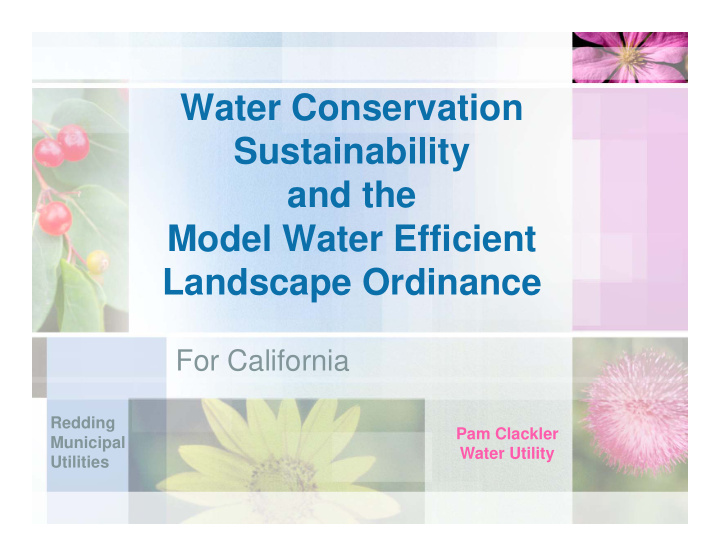



Water Conservation Water Conservation Sustainability and the Model Water Efficient Model Water Efficient Landscape Ordinance For California Redding Pam Clackler Municipal Water Utility Water Utility Utilities
California Constitution Article 10, section 2: Ri ht t Right to water or to the use or flow of t t th fl f water in or from any natural stream or water course in this State is and shall water course in this State is and shall be limited to such water as shall be reasonably required for the beneficial y q use to be served, and such right does not and shall not extend to the waste or unreasonable use
City of Redding Water Utility • 28,000 Service Connections • 2/3 Residential, 1/3 Commercial/Industrial • 83,000 Population • Peak Demand ~ 53 MGD • Annual Use ~ 26,000 ac-ft (8 Billion Gallons) • Outdoor Watering Drives Demand g • City Build-out: 44,000 ac-ft, 88 MGD Peak • Projected Maximum Supply: 65 MGD j pp y
Water Supply • Surface Water – Central Valley Project Contractor C t l V ll P j t C t t – Pre-1914 Water Rights – Two USBR Water Supply Contracts • Groundwater – Redding Groundwater Basin
Surface Water • Water Sources – Sacramento River: 21,000 acre-feet – Whiskeytown Lake: 6,140 acre-feet • Water Treatment – Foothill Water Treatment Plant: 24 mgd g – Buckeye Water Treatment Plant: 14 mgd
Redding Groundwater Basin • 19 Wells: 23 MGD • Capacity: 25,000 acre-feet • Current Use: 9,000 acre-feet , • Seasonal Peaking Supply • Drought Backup • Drought Backup
Water Conservation • Best Management Practices ~ BMPs • Foundational • Foundational • Utility Operations • Education Programs • Education Programs • Programmatic • Residential • Residential • Commercial, Institutional, Industrial ~ CII • Landscape
Model Water Efficient Landscape Ordinance • 1990: AB 325 directed DWR to develop 1990 AB 325 di t d DWR t d l a MWELO • 1993: MWELO becomes law • 1993: MWELO becomes law • 2004: AB 2717 Landscape Task Force • 2005: Water Smart Landscapes for 2005: Water Smart Landscapes for California released by Task Force • 2006: AB 1881 directed DWR to update the MWELO • 2009: Update MWELO becomes law • 2010: Agencies to adopt MWELO or one “at least as effective as:
Assembly Bill 1881- Ordinance Requirements • Provisions • Provisions – Minimize landscape irrigation overspray and runoff – Landscape water budget – Appropriate use and groupings of plants A i t d i f l t – Automatic irrigation systems and schedules – Soil assessment and soil management plans – Landscape maintenance practices • Encourage – Capture and retention of storm water onsite Capture and retention of storm water onsite – Recycled water • Educate – Efficient use of water and the benefits Effi i t f t d th b fit • Promote – Benefits of consistent local ordinances e e ts o co s ste t oca o d a ces
Applicability • Landscapes requiring a building or landscape permit, plan check or design review – Developer installed, public agency projects, & private development project • Landscape area over 2,500 square feet L d 2 500 f t – Homeowner-provided or homeowner- hired hired • Landscape area over 5,000 square feet
New & Rehabilitated Landscapes • Landscape Documentation Package • Certificate of Completion Certificate of Completion
Landscape Documentation Package 1.Project Information 2 Water Efficient Landscape 2.Water Efficient Landscape Worksheet 3.Soil Management Report 4.Landscape Design Plan 5.Irrigation Design Plan 6 Grading Design Plan 6.Grading Design Plan
Project Information • Water Efficiency Application Form pp • Property Owner Signature
Water Efficient Landscape Worksheet • Development of Water Budget Maximum Applied Water Allowance Maximum Applied Water Allowance (MAWA) • Estimated Total Water Use E ti t d T t l W t U Cannot exceed MAWA • Reference Evapo-transpiration Reference Evapo transpiration Weather station – CIMIS • Reference Plant Factor R f Pl t F t Water Use Classification of Landscape Species
Soil Management Report • Soil Analysis – After Mass Grading – Qualified Professional/Lab – Include Recommendations I l d R d ti • Submit Copy – To Landscape and Irrigation Designers To Landscape and Irrigation Designers – Local Agency
Landscape Design Plan • Plant Materials – Hydrozones – Slope/Turf Restriction • Water Features – Recirculating Water – Surface Area - High-water-use • Mulch & Amendments – Minimum 2” Layer – Recommendations Incorporated • Slopes
Irrigation Design Plan • Self-Adjusting Controllers – Weather-based W th b d – Moisture-based • Runoff & Overspray R ff & O – Narrow & Irregular Shaped Areas • Subsurface or Low Volume • Subsurface or Low Volume – 24” Setback: Nonpermeable surfaces – Slopes – Slopes • Restricted Precipitation Rate Confirmed During Audit
Grading Design Plan • Minimize – Soil Erosion – Runoff R ff – Water Waste • Maximize • Maximize – Infiltration – Retention Retention • Avoid – Soil Compaction p – Disruption of Natural Drainage Patterns
Certificate of Completion • Installation Certification – Landscape and Irrigation Plans Landscape and Irrigation Plans • Final Soils Information – Implement Report Recommendations Implement Report Recommendations • Irrigation Scheduling Parameters • Maintenance Schedules M i t S h d l – Irrigation & Landscape • Irrigation Audit Report I i ti A dit R t – Certified Irrigation Auditor
Existing Landscapes • Installed Prior to 01/01/2010 • Over 1 Acre in Size • Local Agency Shall Administer g y Programs to Evaluate Water Use – MAWA Compliance – Provide Recommendations – Audits
Contact Information • Pam Clackler • Water Conservation Specialist p • Redding Municipal Utilities • 530 224 6032 phone • 530-224-6032 phone • pclackler@ci.redding.ca.us • Be Water Wise
Recommend
More recommend